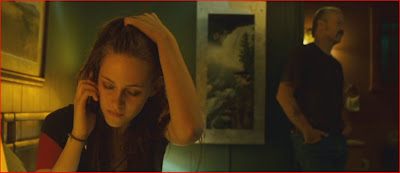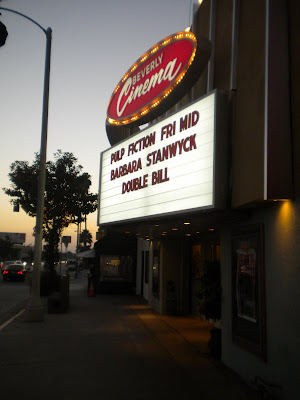 The Yellow Handkerchief
The Yellow Handkerchief, directed by Udayan Prasad (
My Son, the Fanatic) from a screenplay by Erin Dignam based on a story by Pete Hamill, is certainly one of the loveliest movies of the year. Set in Louisiana in the months just after Hurricane Katrina (an event which is never directly addressed but which hangs over the movie like a gathering thundercloud),
The Yellow Handkerchief follows the tentative steps of a recently freed ex-con (William Hurt) whose prison term for an initially undisclosed offense has alienated him from the outside world. He hits the road with a young runaway (Kristen Stewart) and a self-conscious boy (Eddie Redmayne) who claims Native American heritage, even though he looks like Howdy Doody's lanky older brother, in search of some way back into society, all the while haunted by the memory of a woman he once loved (Maria Bello). Any description such as this is likely to make the movie sound as if it were hamstrung by character cliche and weather-worn plot devices, and to give no sense whatsoever of the pleasures of the movie's lingering ghostliness, or of its sensitivity to the way the world looks through a pair of jaded eyes which have been denied for far too long the sight of a rain-filled sky or the way daylight illuminates a glass of beer. Prayad, a talent unknown to me before seeing this film, guides Hurt to a career-best performance in which tremors of pain are communicated with a simple glance, a dead-eyed stare, a quiet turning away. The rest of the actors are just as good-- Redmayne is sympathetic even at his most obnoxious (he has the off-kilter stare of the socially inept down pat, and we're never quite sure where he's coming from, which in this case is a good thing); Bello is solid as usual and a welcome presence, even if she has fewer moments to work true magic than Hurt; and Stewart is animated and in tune with with her surroundings in a way I've never seen from her before, feeding off the energy of actors like, well, new blood.
Bu the movie's real star is
Chris Menges, master of light and composition, who infuses
The Yellow Handkerchief with a pallet alive to the connections between the actors and their environment, placing them within a world that seems not only alive but unpredictable in its beauty, its danger, its portent, and its accidental magic. Menges has been shooting features since 1962, and he was probably first noticed by discerning audiences abroad and in the U.S. for the images he made for Neil Jordan's
Danny Boy (1982). But it was his next feature,
Local Hero (1983), which he shot for director Bill Forsyth, that showcased his brilliance and instantly made him one of the most sought-after, fascinating and original "lighting cameramen" in cinema history. In subsequent years Menges has lent his talent to the visualization of moving (in the emotional sense), shimmering, achingly beautiful movies as
Comfort and Joy, The Killing Fields, Marie, High Season, Michael Collins, Dirty Pretty Things, The Good Thief and
The Three Burials of Melquiades Estrada before bringing his conjuring of light and texture to bear on
The Yellow Handkerchief. It is a fine movie, its more conventional elements made finer by the gasp-inducing beauty Menges interlaces through the movie's spectral fragility, its sense of a world stirred up by nature which hasn't quite settled back into the patterns of the usual. When I saw the movie last week I was so taken by the movie's masterly presence with the wide-screen frame and the power it draws from Menges' vision that I felt the best "review" would be a tour, sans comment, through some of its most evocative images, disconnected from the flow of the narrative, as solitary illustrations of singular pictorial beauty sans preciousness, of the power of pictures without sound.
And as soon as I started contemplating how Menges' most powerful work has always traveled that open-air corridor between the recognizably human and the natural world in which human drama plays out, of course I began flashing back to similar (and dissimilar imagery) from the movie that first impressed Menges on my receptors,
Local Hero. Here then are two visual essays, if you will, in which I've chosen not to compete with the imagery through clever or self-consciously poetic captions, but to simply let some of the most indelible, magical images from each movie speak for themselves. Each shot is an expressive beauty on its own, but each movie also has a shot or series of shots that required more than one screengrab to adequately convey the true splendor of the sequence. I'm thinking especially of the transcendent majesty of the way the convertible cuts through the water that partially floods the marsh road from
The Yellow Handkerchief (a helicopter shot adorned with a grace note of a sea bird flying right to left in the shot in perfect compliment to the speed of the car). Then compare that to one of the most magical sequences of any modern movie, from
Local Hero, when the townspeople gather on the beach and head toward a showdown with old man Knox over property rights to their seaside village and are, incredibly, followed by a celestial object, perhaps the moon moving of its own accord, which turns out to be something both of the sky and of the earth that, improbably, delivers the solution to their problem.
The transfer on the DVD of
Local Hero leaves much to be desired, but even an indifferent digitalization cannot muffle the comfort and joy with which Menges envelopes the audience in Forsyth's film. And in
The Yellow Handkerchief he provides a beautiful visual bookend that demonstrates much of the same visual ingenuity and intuition that has only become richer over the years, a map of the ethereal highway traveled by humans who reach out to a God who may be present only in the details of contrasting natural light, in the vision of peeling paint on a church draped in willows, or the pain on the faces of people who find no solace in a touch, and only yearning to fill the space between.
*************************************************
Visions in Shadows and Light-- Chris Menges #1, The Yellow Handkerchief (Click on each image to enlarge)*************************************************

































***********************************************
(Scroll down for "Visions in Shadows and Light-- Chris Menges #2, Local Hero)***********************************************
 This is incredibly sad news to report. Those who have followed Quentin Tarantino's career are well familiar with the name Sally Menke, who was the director's film editor for every movie he made, from Reservoir Dogs in 1992 to last year's Inglourious Basterds. Menke went hiking with her dog during a wave of extreme heat yesterday (Los Angeles temperatures hit a record high of 113 on Monday) and was discovered dead early this Tuesday morning by rescue searchers combing the Beachwood Canyon area.
This is incredibly sad news to report. Those who have followed Quentin Tarantino's career are well familiar with the name Sally Menke, who was the director's film editor for every movie he made, from Reservoir Dogs in 1992 to last year's Inglourious Basterds. Menke went hiking with her dog during a wave of extreme heat yesterday (Los Angeles temperatures hit a record high of 113 on Monday) and was discovered dead early this Tuesday morning by rescue searchers combing the Beachwood Canyon area.


































































